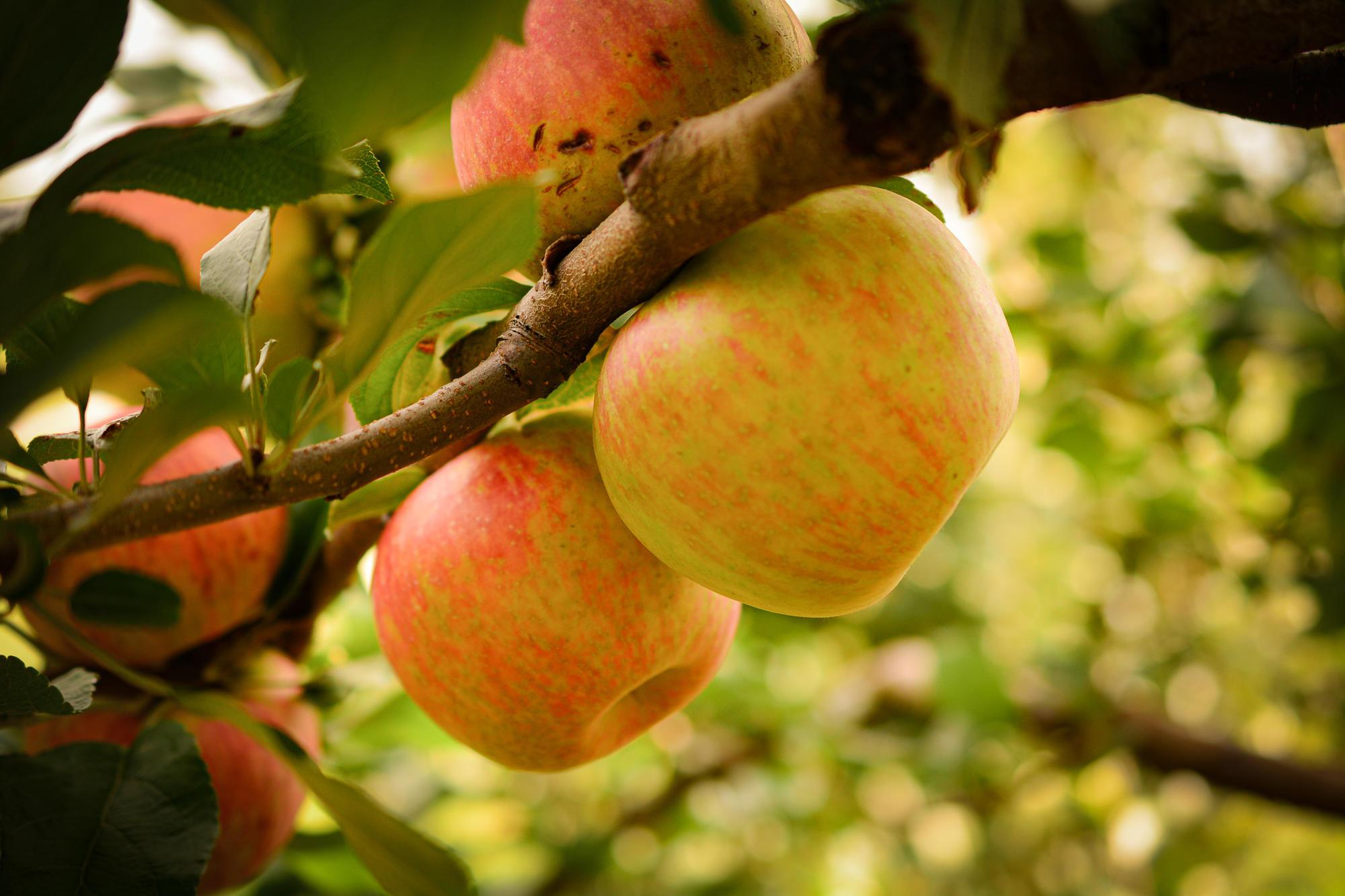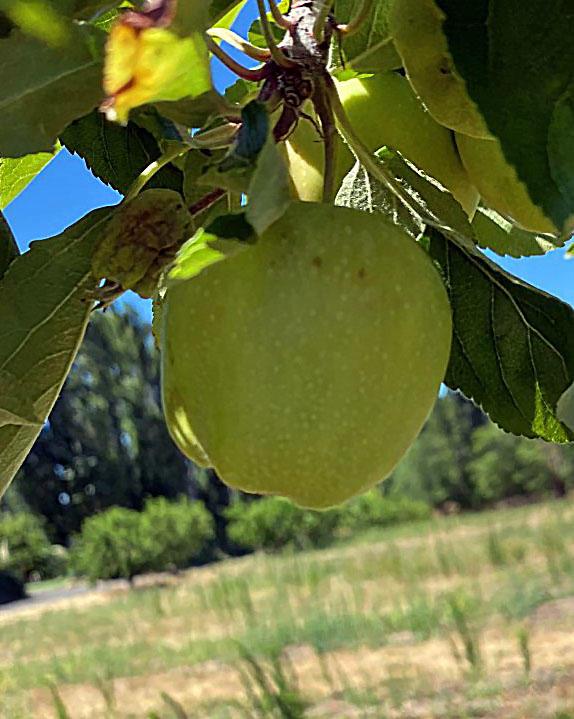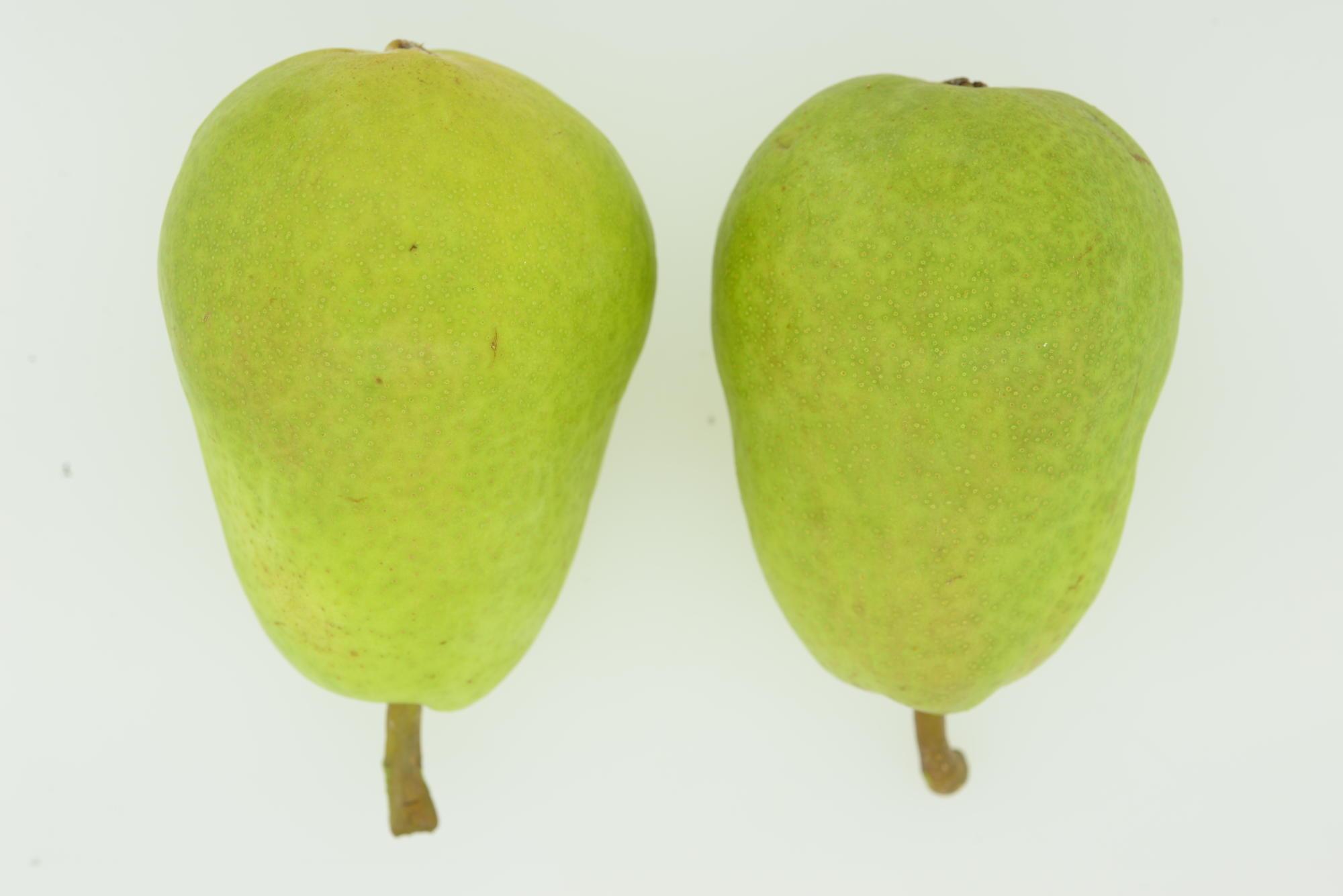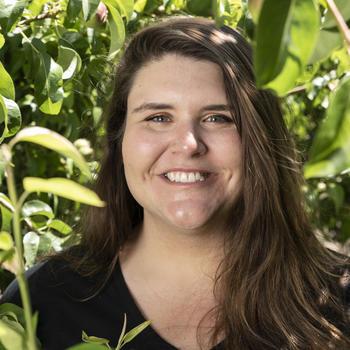Ashley Thompson, Kelsey Galimba and Eliott Gloeb
For the best apples and pears, home orchardists and small farmers pick fruit at optimum maturity. Apples and pears harvested at the right time taste better than fruit picked at other times. They store better, too. This guide to harvesting apples and pears will help you time it right.
Section anchor "climate-and-weather"
Climate and weather
Typically, a given variety of apple (Malus domestica) or pear (Pyrus communis) will reach maturity around the same time each year. Climatic conditions in different areas affect when fruit reaches maturity. Fruit will mature earlier in warmer regions than in colder regions.
Harvest time for a specific region can vary slightly from year to year due to weather conditions. For example, later-than-normal flowering due to cold spring temperatures can mean a later harvest.
Oregon apple and pear production can be divided into four regions, based on when fruit typically reaches maturity:
- Early: Jackson County, Milton-Freewater and Wasco County
- Middle: Lower Hood River Valley, Malheur County, Douglas County and Josephine County
- Mid to late: Willamette Valley, Upper Hood River Valley
- Late: High mountains and plateaus and the coast
Early regions may begin harvest 10 days earlier than midseason regions. Late regions typically begin 10 days later than the midseason regions.
Section anchor "picking-apples-and-pears"
Picking apples and pears
Pick apples and pears from the tree using the gentle motions described in “Ease of separation.” Do not shake fruit off the tree — this causes bruising and damage. Bruised and damaged fruit is not fit for storage and must be used quickly.
Apples
Table 1 shows typical harvest maturity dates for common apple varieties. There are several signs of apple maturity:
- Color
- Firmness
- Flavor
- Ease of separation
- Dropping
These characteristics can help you determine when to harvest your apples. But the simplest way to test the maturity of your fruit is to cut it open and taste it.
| Variety | Harvest timing | Skin color at maturity |
|---|---|---|
| Gravenstein | Mid-August | Yellow with red stripes |
| Pristine | Mid-August | Yellow with pink blush |
| Gala | August–September | Yellow with red stripes |
| Zestar | August–September | Yellow with red blush |
| Liberty | Early September | Red |
| Akane | Mid-September | Yellow with red stripes |
| Ambrosia | Mid-September | Red-orange |
| Golden Delicious | Mid-September | Yellow |
| Honeycrisp | Mid-September | Yellow with red blush |
| McIntosh | Mid-September | Yellow with red blush |
| Cameo (Carousel) | September–October | Red |
| Cosmic Crisp | September–October | Red |
| Empire | September–October | Red |
| Fuji | September–October | Red |
| Jonagold | September–October | Yellow with red stripes |
| Melrose | September–October | Yellow-green with red stripes |
| Red Delicious | September–October | Dark red |
| Braeburn | Mid-October | Yellow with red blush and red stripes |
| Enterprise | Mid-October | Red |
| Pink Lady (Cripps Pink) | Mid-October | Pink |
| Spitzenburg | Mid-October | Yellow with red stripes |
| Winesap | Mid-October | Red |
| (Yellow) Newtown Pippin | Mid-October | Yellow-green |
| Granny Smith | Late October | Green |
Color
The color of the skin and flesh can indicate maturity. Ripe apples come in red, yellow, green or a combination of these colors. Typically, the skin of yellow, red, blush and striped varieties remains green until they are mature, or close to mature.
You can also check the “ground color” — the base color of the apple skin. The ground color is most noticeable at the bowl of the stem, particularly in striped and blush varieties like ‘Gala’ and ‘Honeycrisp’. As the apple ripens to maturity, the ground color will change from green to yellow.
Skin color in some varieties can be misleading. Some red apple varieties, such as ‘Red Delicious’, become red before they are fully mature. You can also look at flesh color — it should be white or cream-colored, not green.
The color of the seed coat will change from white to brown when fruit is mature.
Firmness and flavor
The firmness of an apple and its flavor are useful guides to maturity. A mature apple will be firm, crisp and sweet with a well-developed flavor characteristic of the variety. Apples harvested too early are hard, tart and starchy. Apples harvested too late are soft and mushy — often described as mealy — with poor flavor.
Ease of separation
Mature apples are easily separated from the tree. The best way to pick an apple is to gently grasp the bottom of the apple in the palm of your hand. Gently twist the fruit upwards. Pulling down on the apple can cause the stem to separate from the fruit or the spur to break off the tree.
Gently grasping with your palm reduces the likelihood of bruising the fruit with your fingers. Bruised apples and apples without stems do not store well. Be gentle when harvesting your fruit.
Fruit drop
When a few sound apples drop to the ground, the apples on the tree are nearly mature.
Pears
Unlike apples, most pear varieties do not ripen to good quality while still on the tree. Pears ripen from the core outward and from the neck towards the calyx end. Pears that ripen on the tree will develop a coarse, mealy texture. Their cores often break down.
The two types of European pears — summer and winter pears — are classified by harvest dates and the postharvest conditions required for them to ripen. Pick both types when mature but not ripe.
As with apples, it’s important to know the usual period of maturity.
Color
The skin of ‘Bartlett’, ‘D’Anjou’ and ‘Comice’ will change from a bright green to a lighter green, slightly yellow color as they reach maturity. This trait is most apparent in ‘Bartlett’. The skin of some pears, like ‘Bosc’ and ‘Starkrimson’, will not change color. Pear flesh will become whiter and the seeds will be brown.
Firmness and flavor
Firmness and flavor are not the best measures of maturity for pears in the home orchard. Pears that ripen on the tree will be poor in flavor and texture.
Harvest your pears when they are still hard. Pears that are hard but sweet are ready to pick. If they are hard and starchy, they need more time on the tree. This rule is more important for early and midseason pears.
Ease of separation
Mature pears usually detach easily when tilted to the horizontal position from their vertical hanging position. ‘Bosc’ pears, however, are always difficult to remove from the spur. Like with apples, grasp pears gently with your palm to reduce the likelihood of bruising the fruit with your fingers.
Fruit drop
Unlike as in apples, fruit drop is not considered a key maturity trait for pears.
| Variety | Harvest timing | Period of cold storage before ripening | Skin color when ripe |
|---|---|---|---|
| Starkrimson | August | N/A | Crimson-red |
| Bartlett | August–September | None | Yellow-gold |
| Clapps Favorite | August–September | None | Yellow with red blush |
| Gem | August–September | None | Yellow with red blush |
| Red Bartlett | August–September | None | Red |
| Bosc | September | None | Cinnamon with russeting |
| Comice | September | 1 month | Green with red blush |
| Forelle | September | 1 month | Yellow with red lenticels |
| Seckel | September | None | Green with red blush |
| Taylor's Gold | September | N/A | Cinnamon with russeting and red blush |
| Concorde | September–October | N/A | Yellow-green with russeting |
| Green Anjou | September–October | 2 months | Green with red blush |
| Red Anjou | September–October | 2 months | Maroon |
| Winter Nelis | September–October | 1 month | Green with russeting |
Section anchor "storing-apples-and-pears"
Storing apples and pears
Proper storage conditions help you make the most of your harvest. Store fruit immediately after picking.
Store apples and pears in clean wooden or cardboard boxes. Use boxes that are ventilated to allow air circulation. You can place fruit in unsealed or perforated plastic bags. Do not line the boxes with paper or individually wrap the fruit.
Don’t wash apples and pears before storing them. The excess moisture from washing will hasten fruit decay.
Do not store bruised apples or pears or fruit with insect and disease damage. Damaged fruit will spoil in storage. The presence of spoiled fruit can cause healthy fruit to ripen and rot more quickly.
Temperature
Temperature control is vital to fruit storage.
Most apples and pears store best in dark conditions. Temperature should range between 30°F and 32°F.although fruit may be stored at temperatures up to 40°F. Some apple varieties, such as ‘McIntosh’ and ‘Honeycrisp’, are prone to chilling injury. Store these at 38°F.
It is easiest to control and monitor temperature in a refrigerator. But an unheated garage, cold basement or root cellar may work if you can maintain temperatures between 30°F and 45°F. Storing fruit at lower or higher temperatures can hasten spoilage or loss of quality.
Apples and pears freeze at 29°F. You can sometimes salvage partially frozen pears, but freezing ruins apples.
Apples and pears spoil faster at temperatures above 45°F.
Humidity
Store pears and apples at 90% relative humidity. This can be challenging to achieve in certain conditions. Place fruit in unsealed or perforated plastic bags to help maintain humidity while allowing excess moisture to escape. You can also place an open pan of water in storage to increase humidity. Low humidity can cause fruit to dehydrate and shrivel,
| Variety | Days storage life at 30ºF–32ºF | Days storage life at 40ºF–42ºF |
|---|---|---|
| Pears | ||
| Bartlett | 30–45 | 15–20 |
| Bosc | 50–70 | 30–40 |
| D'Anjou | 120–140 | 70–80 |
| Comice | 79–90 | 45–55 |
| Winter Nelis | 160–180 | 90–100 |
| Apples | ||
| Gravenstein | 60–80 | 40–50 |
| Tydeman's Red | 60–80 | 40–50 |
| McIntosh | * | 60–80 |
| King | 120–180 | 90–105 |
| Golden Delicious | 130–150 | 75–85 |
| Red Delicious | 120–180 | 90–105 |
| Rome Beauty | 120–180 | 90–105 |
| (Yellow) Newtown Pippin | 120–180 | 90–105 |
| Melrose | 120–180 | 90–105 |
| Honeycrisp** | * | - |
| Pink Lady | N/A | N/A |
| Fuji | N/A | N/A |
| Gala | N/A | N/A |
*Subject to cold temperature injury. Hold at 38ºF–42ºF.
**Store at 50ºF for one week before cold storage
Quality and ripening
The storage life of apples and pears varies according to the variety and storage temperature. Pears held beyond their normal storage life will not ripen after removal from storage. Apples held too long will be soft and mealy and may have internal breakdown.
Ripen pears before you eat them. Remove the fruit from cold storage and place it at room temperature (60°F –70°F) for three to 10 days. ‘D’Anjou’ and ‘Comice’ pears will not ripen unless they have been held in cold storage for at least eight to 10 weeks before ripening.
How do I know when a pear is ripe?
The skin of ‘Bartlett’ pears will change from green to a lighter yellow-green color. Most other pear varieties do not exhibit a dramatic change in skin color when ripe.
The best way to determine if a pear is ripe is to “check the neck.” Apply light pressure to the stem end (the neck) of the pear with your thumb. A ripe pear will yield to the gentle pressure.
You can slow down the ripening process and save your ripe pear for up to five days by placing it in the refrigerator.






